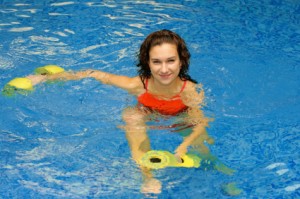Aquatic Exercises For Hip Pain
May 9, 2011 by Eric
Filed under Fitness and Exercise
Some of the better types of exercises for hip pain, especially for those folks with poor balance are going to be water-based. There are very specific benefits that you won’t get from exercising on land. While water exercises are great no matter what your age, exercising in the water is particularly beneficial for people over 40 who are beginning to experience conditions commonly associated with aging like hip joint pain.
Get into the water up to your shoulders and your body will bear only 10% of your normal weight due to a phenomenon known as buoyancy. Because buoyancy essentially eliminates gravity, there is no compression on your joints, which, means no pain and little chance of being injured when you move.
A study conducted by the Journal of Geriatrics and Gerontology International investigated the effects of water-based versus land-based exercise on women in their early sixties over a 12-week period. While both groups experienced increased strength, flexibility and aerobic fitness over the control group which didn’t exercise, water exercise was more accessible to the older women, because they weren’t afraid of falling and breaking a bone when exercising in the water.
An excellent way for obese individuals to begin an exercise program is by swimming because it doesn’t put pressure on the joints. Another year-long study looking older women who swam and walked, found that the swimmers lost slightly more weight and lowered their cholesterol slightly more than the walkers.
According to a more recently published study, hip osteoarthritis was reduced in a majority of adults 65 years and older who engaged in water exercise two times a week,. However, the only adults who decreased their risk of falling and improved their functional performance were those who were also educated about the impact of regular exercise on daily living — for example, how the ability to stand from a seated position is improved by doing squats in the water.
The common problem of overheating that older adults experience while exercising is virtually eliminated with swimming, as well as the risk of injury. The benefits gained from a swimming program will depend on the water exercises performed. A variety of programs exists that will take you from basic through advanced water workouts.
Many lap swimmers think they’re getting a good workout when they’re actually not. It’s pretty easy to get into a routine of doing a few lazy laps and calling it quits. A high-quality workout, on the other hand, involves increasing resistance (by pushing as much water as possible) and cardiovascular strength (by putting substantial effort into your laps).
Taking a swimming class will help improve your stroke; use kick-boards, hand paddles, flippers, buoys, and other equipment; and helps in learning additional skills that ensure you’re getting a vigorous workout. You’ll also learn the correct way to position and move your hand, as well as other subtle skills that determine the precise muscles being exercised and the amount of water being resisted.
An excellent cardiovascular workout and strength training through resistance is the key components of water exercise. Of course, the benefits you experience will depend on the effort you put into it. A good instructor will help you move fast enough to provide the right amount of resistance and a cardio workout that’s just right for you.
A challenging swim, three to five times a week, at your local swim club or YMCA/YWCA will ensure you’re getting the many benefits swimming provides.



